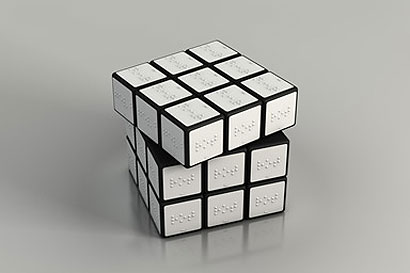|
|
||
|
Of all the iPad apps, information visuals, avatars, gadgets, network systems and interfaces now on view at New York’s Museum of Modern Art, the most striking piece of design is the show itself. With QR codes and hashtags littering every placard of wall text for the show’s 200+ projects and an online catalogue accompanying its print counterpart in the form of a Flash-happy blog, “Talk to Me” attempts to operate on as many social media platforms as possible. It’s a fitting exploration of how a museum exhibit can speak to visitors in today’s tech-savvy world. Senior curator Paola Antonelli’s career at the MoMA is characterised by a consistent knack for picking up on design’s future trends – recall her 2008 show Design and the Elastic Mind. With her latest collection of cutting-edge works, she has once again momentarily captured the moving target of technology. Some of them – such as “Touch Hear”, a finger implant with text-recognition capabilities – are otherworldly concepts still awaiting development. The majority of the show’s “pieces”, for lack of a better word, draw on the explosion of interaction design over the past half-decade. That design objects are “interactive” is not new – anything requiring physical use could be considered so – but the selected works embody the term in ways often strangely new, emotional and conceptual.
credit Konstantin Datz Old-fashioned adages concerning form and function are quickly transcended by an array of media whose true designs come to surface only upon human activation. Flat, virtual touchscreens become stringed instruments of layered sound with the swipe of a hand; plastic toys in the shape of Japanese kanji characters unfold to mirror the semantic meanings of the pictograms from which they originate; a Rubik’s Cube for the blind cleverly swaps colour for Braille to transform a visual puzzle into a tactile one; and a bird-shaped light switch with varying facial expressions becomes a comforting, transitional object that also teaches children when to save energy and turn it off. As you continue through the exhibition, your attention ricocheting from one attraction to the next, it becomes increasingly difficult to group the collection into any one family of things. The limitations of spoken and written language become palpable and multi-sensory in a beautiful structuralist demonstration of bricolage. The critical force driving the show seems to be that communication happens on multiple, expansive levels. It’s an ambitious message, but so large in scope that it nearly eclipses the logistics of exhibition design. Projects are clumsily lumped together, and wayfinding words meant to evoke commonalities (“life,” “objects”, “worlds”) are ineffectual and worrisome. Without sifting carefully through the layers of content embedded in the show’s various hyperlinks and QR codes for more context, it’s difficult to feel as if you’ve come upon more than a trade show of sci-tech wonders and fetishes. Visitors are as much a part of the show as the USB sticks that jut out from the exhibition walls and in this case seeing really is believing – one need only observe the other visitors as they shuffle about impatiently, scanning the works with their smartphones and skipping over those already out of commission (just one week after the exhibit’s opening, I counted at least three). In an age driven by interaction and social media, in which noun, verb and brand become one and the same, Antonelli’s loose thesis becomes jarringly real. Designed objects now “talk” to us, and we with one another, in ways unprecedented and proliferated by technology. However, as to whether these forms of communication are better than an old-fashioned tête-à-tête, this particular multi-tasking Millennial remains ambivalent.
credit POKE Talk to Me: Design and the Communication between People and Objects is at the Museum of Modern Art, New York until 7 November 2011. |
Image Bernhard Hopfengartner
Words Aileen Kwun |
|
|
||




















